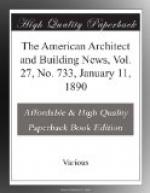The cost of the building we do not give, because it would be useful as showing how much, rather than how little, could be put into such an edifice. It contains, besides the museum proper, the floor-space of which amounts to about 10,000 square feet, a lecture-hall with a seating-capacity of about 1,200, a library and four large class-rooms, which, if the intentions of the founder are fully carried out, will be used for practical instruction in the fine arts. Desirable as all these rooms are in a building of the kind, the only one which seems to us absolutely necessary is the lecture-hall. To open a gallery like this to the public, and then leave people to float about in it aimlessly, without a notion of its meaning or its purposes, is to do but half the work. Either regular courses of instruction or occasional lectures upon topics connected with the theory or history of art are necessary in order to make the Museum anything more than a collection of curiosities to the uninitiated, and such lectures are given during the winter at the Slater Museum.
Of the amount just quoted, the principal item was naturally for casts. The cost of these, including packing and transportation, but not setting-up in the Museum, was $13,968.68, making an average of a trifle less than $62 for each number in the catalogue. We ought to say here, however, that an average is a dangerous guide in a matter of this kind, owing to the enormous difference in the size and price of casts, as well as in the distance from which they come. Obviously, too, the cost of packing and importing a few casts would be proportionately much greater than in a large order.




